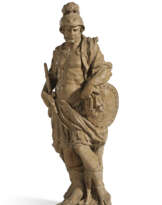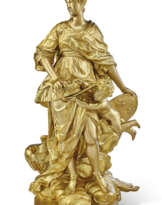ID 1173006
Lot 62 | FEMME VÊTUE À L’ANTIQUE, PEUT-ÊTRE FLORE
Estimate value
€ 2 500 – 3 500
POSSIBLEMENT PAR GUILLAUME I COUSTOU (1677-1746) OU GUILLAUME II COUSTOU (1716-1777), DATÉE 1745
terre cuite, représentée debout tenant une guirlande de fleurs, une urne à ses pieds, monogrammée ‘C’ au revers et datée ‘1745’ ; éclat à la terrasse, doigt manquant
H. 71 cm (28 in.) ; L. 20 cm (8 in.)
Literature
Bibliographie comparative :
S. Lami, Dictionnaire des sculpteurs de l’école française sous le règne de Louis XIV (...), Paris, 1906, pp. 115-120.
S. Lami, Dictionnaire des sculpteurs de l’école française au dix-huitième siècle, tome 1, Paris, 1910, pp. 235-240.
Further details
A TERRACOTTA FIGURE OF A WOMAN, PROBABLY FLORA, POSSIBLY GUILLAUME I COUSTOU (1677-1746) OR GUILLAUME II COUSTOU (1716-1777), DATED 1745
This terracotta figure, standing and holding a garland of flowers, could be that of the agrarian deity Flora, whose main role is to protect the flowering of cereals and fruit trees. Monogrammed ‘C’ on the reverse and dated ‘1745’, it has been compared to works by Guillaume I Coustou (1677-1746) and Guillaume II Coustou (1716-1777).
Guillaume I Coustou was born in Lyon. He was the son of François Coustou, a master carpenter, and Claudine Coysevox, sister of the sculptor Antoine Coysevox (1640-1720). Once settled in Paris, Guillaume I Coustou joined his uncle Coysevox’s workshop. After winning first prize in sculpture at the École académique in 1697, he went to Rome where he was employed by Pierre II Legros (1666-1719) to work on the relief of Saint Aloysius Gonzaga in the Jesuit church of Sant’Ignazio di Loyola. On his return to France, he was admitted to the Académie in 1704. He was subsequently appointed professor in 1715, rector in 1733 and finally director between 1735 and 1738. He is mentioned for the first time in 1707 in the accounts of the King’s buildings, the year in which he collaborated on the decoration of the chapel at the Château de Versailles. He later worked at Trianon and executed numerous figures for the park at Marly. In Paris, his works adorned the portal of the Invalides, the Palais Bourbon and the ‘grande chambre du parlement’ in the Palais de Justice.
His son, Guillaume II Coustou, was born in Paris in 1716. He won the first prize for sculpture in 1735 and was appointed student sculptor at the Académie de France in Rome. He spent five years there before returning to Paris in 1740. There, he worked at the Louvre, the Hôtel des Ambassadeurs extraordinaires, the Samaritaine, the church of Sainte-Geneviève and the Écoles de droit. He also created a bronze relief for the chapel at Versailles, and worked on the châteaux of Bellevue, Crécy, Choisy, Compiègne and Saint-Hubert.
| Artist: | Guillaume Coustou (1677 - 1746) |
|---|---|
| Applied technique: | Pottery |
| Medium: | Ceramic, Terracotta |
| Genre: | Mythological painting |
| Place of origin: | Western Europe, France, Europe |
| Auction house category: | Sculptures, Statues & Figures, Statuettes |
| Artist: | Guillaume Coustou (1677 - 1746) |
|---|---|
| Applied technique: | Pottery |
| Medium: | Ceramic, Terracotta |
| Genre: | Mythological painting |
| Place of origin: | Western Europe, France, Europe |
| Auction house category: | Sculptures, Statues & Figures, Statuettes |
| Address of auction |
CHRISTIE'S 9 Avenue Matignon 75008 Paris France | ||||||||||||||
|---|---|---|---|---|---|---|---|---|---|---|---|---|---|---|---|
| Preview |
| ||||||||||||||
| Phone | +33 (0)1 40 76 85 85 | ||||||||||||||
| Fax | +33 (0)1 40 76 85 86 | ||||||||||||||
| Conditions of purchase | Conditions of purchase | ||||||||||||||
| Shipping |
Postal service Courier service pickup by yourself | ||||||||||||||
| Payment methods |
Wire Transfer | ||||||||||||||
| Business hours | Business hours
|





